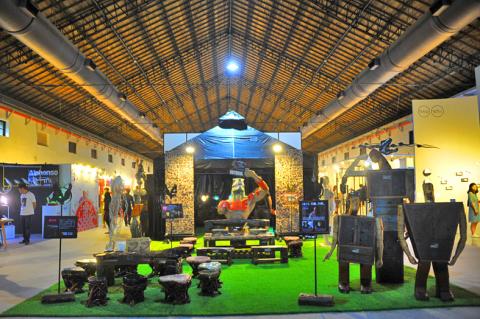Within a few minutes of entering the Creative Expo Taiwan at Songshan Cultural and Creative Park, one of three venues hosting the massive event, you encounter a traditional sheet metal factory that partners with designers to make sheet metal furniture and Taiwanese deity robots, a studio that fuses wood and leather.
Of course there are the more standard items and the corporate and government promotional stuff, but that is how most expos of the sort are — you have to dig for the gems.
This year’s theme is “Savoring the Rich Eastern Culture,” with a themed pavilion curated by professionals from Taiwan, Japan, UK and Denmark. The expo includes a number of forums, exhibits, performances and activities and also links visitors with more than 200 nearby creative shops.

Photo: Han Cheung, Taipei Times
■ This year’s expo is open to the public today and tomorrow from 10am to 9pm and Sunday from 10am to 6pm.
■ Huashan 1914 Creative Park (華山1914), 1, Bade Rd Sec 1, Taipei City (台北市八德路一段1號) hosts the craft section, Cultural and Creative Park (松山文創園區), 133, Guangfu S Rd, Taipei City (台北市光復南路133號) hosts the design section and the Taipei Flora Expo Park (台北花博公園), 1, Yumen Street, Taipei City (台北市玉門街1號) hosts the licensing section. Tours are available between 11am and 6pm. For more information, visit the English Web site at www.creativexpo.tw/en.

The canonical shot of an East Asian city is a night skyline studded with towering apartment and office buildings, bright with neon and plastic signage, a landscape of energy and modernity. Another classic image is the same city seen from above, in which identical apartment towers march across the city, spilling out over nearby geography, like stylized soldiers colonizing new territory in a board game. Densely populated dynamic conurbations of money, technological innovation and convenience, it is hard to see the cities of East Asia as what they truly are: necropolises. Why is this? The East Asian development model, with

June 16 to June 22 The following flyer appeared on the streets of Hsinchu on June 12, 1895: “Taipei has already fallen to the Japanese barbarians, who have brought great misery to our land and people. We heard that the Japanese occupiers will tax our gardens, our houses, our bodies, and even our chickens, dogs, cows and pigs. They wear their hair wild, carve their teeth, tattoo their foreheads, wear strange clothes and speak a strange language. How can we be ruled by such people?” Posted by civilian militia leader Wu Tang-hsing (吳湯興), it was a call to arms to retake

This is a deeply unsettling period in Taiwan. Uncertainties are everywhere while everyone waits for a small army of other shoes to drop on nearly every front. During challenging times, interesting political changes can happen, yet all three major political parties are beset with scandals, strife and self-inflicted wounds. As the ruling party, the Democratic Progressive Party (DPP) is held accountable for not only the challenges to the party, but also the nation. Taiwan is geopolitically and economically under threat. Domestically, the administration is under siege by the opposition-controlled legislature and growing discontent with what opponents characterize as arrogant, autocratic

Desperate dads meet in car parks to exchange packets; exhausted parents slip it into their kids’ drinks; families wait months for prescriptions buy it “off label.” But is it worth the risk? “The first time I gave him a gummy, I thought, ‘Oh my God, have I killed him?’ He just passed out in front of the TV. That never happens.” Jen remembers giving her son, David, six, melatonin to help him sleep. She got them from a friend, a pediatrician who gave them to her own child. “It was sort of hilarious. She had half a tub of gummies,